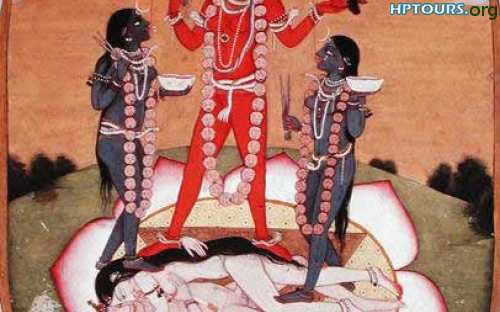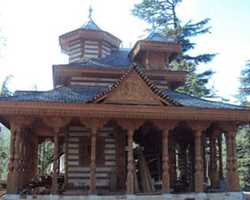Chhinnamasta (Sanskrit: छिन्नमस्ता, Chinnamastā, "She whose head is severed"), often spelled Chinnamasta and also called Chhinnamastika and Prachanda Chandika, is one of the Mahavidyas, ten Tantric goddesses and a ferocious aspect of Devi, the Hindu Divine Mother. Chhinnamasta can be easily identified by her fearsome iconography. The self-decapitated goddess holds her own severed head in one hand, a scimitar in another. Three jets of blood spurt out of her bleeding neck and are drunk by her severed head and two attendants. Chhinnamasta is usually depicted standing on a copulating couple.
Chhinnamasta is associated with the concept of self-sacrifice as well as the awakening of the kundalini – spiritual energy. She is considered both as a symbol of self-control on sexual desire as well as an embodiment of sexual energy, depending upon interpretation. She symbolizes both aspects of Devi: a life-giver and a life-taker. Her legends emphasize her sacrifice – sometimes with a maternal element, her sexual dominance and her self-destructive fury. Though she enjoys patronage as part of the Mahavidyas, her individual temples – mostly found in Northern India and Nepal – and individual public worship is rare, due to her ferocious nature and her reputation of being dangerous to approach and worship. Her individual worship is restricted to heroic, Tantric worship by Tantrikas, yogis and world renouncers.
Chhinnamasta is recognized by both Hindus and Buddhists. She is closely related to Chinnamunda – the severed-headed form of the Tibetan Buddhist goddess Vajrayogini.
Chhinnamasta is popular in Tantric and Tibetan Buddhism, where she is called Chinnamunda ("she with a severed head") – the severed-head form of goddess Vajrayogini or Vajravarahi – a ferocious form of the former, who is depicted similar to Chhinnamasta.[1]
Buddhist texts recount the birth of the Buddhist Chinnamunda. One tale tells of Krishnacharya's disciples, two Mahasiddha sisters, Mekhala and Kankhala, who cut their heads, offered them to their guru and then danced. The goddess Vajrayogini also appeared in this form and danced with them. Another story recalls princess Lakshminkara, who was a previous incarnation of a devotee of Padmasambhava, cut off her head as a punishment from the king and roamed with it in the city, where citizens extolled her as Chinnamunda-Vajravarahi
--











Comment with Facebook Box